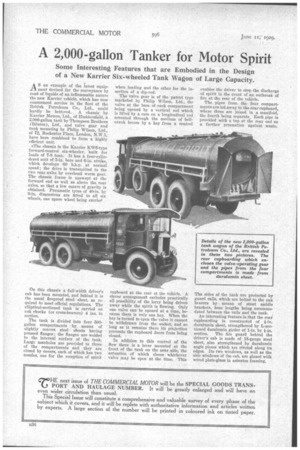A 2 000-gallon Tanker for Motor Spirit
Page 62

If you've noticed an error in this article please click here to report it so we can fix it.
Some Interesting Features that are Embodied in the Design of a New Karrier Six-wheeled Tank Wagon of Large Capacity.
1:1.
A S an example of the latest equip
meat devised for the conveyance by road of liquids of an inflammable nature the new Karrier vehicle, which has now commenced service in the fleet of the British Petroleum Co., Ltd., could hardly be bettered. , A chassis by Karrier Motors, Ltd., of Huddersfield, a 2.000-gallon tank by Thompson Brothers (Bilston), Ltd., and valve gear and tank mounting by Philip Wilson, Ltd., of 72, Rochester Place, London, N.W.1, have been combined to form a highly efficient unit.
The chassis is the Karrier KWEI-type forward-control six-wheeler, built for loads of 7-8 tons. It has a four-cylindered unit of 5-in. bore and 6-in, stroke, which develops 60 b.h.p. at normal speed ; the drive is transmitted to the two rear axles by overhead worm gear. The chassis frame is upswept at the forward end as well as above the rear axles, so that a low centre of gravity is obtained. Pneumatic tyres of 40-in. by 0-in, dimensions are fitted. to all six wheels, one spare wheel being carrietl
On this chassis a full-width driver's cab has been mounted, and behind it is the usual fireproof steel sheet, as required to meet official regulations. The elliptical-sectioned tank is carried on oak chocks (or cross-bearers) 4 ins, in section.
The tank is divided into four 500gallon compartments by means of slightly convex steel sheets having pressed flanges; the flanges are welded to the internal surface of the tank. Large manholes are provided to three of the compartments and they are closed by covers, each of which has two nozzles, one for the reception of spirit when loading and the other for the insertion of a dip-rod.
The valve gear is of the patent type marketed by Philip Wilson, Ltd., the valve at the base of each compartment being opened by a vertical rod which is lifted by a cam on a longitudinal rod actuated through the medium of bellcrank levers by a key from a control
cupboard at the rear ot the vehicle. A clever arrangement excludes practically all possibility of the lorry being driven away while the spirit is flowing. Only one valve can be opened at a time, because there is only one key. When the key is turned to open the valve it cannot be withdrawn from the socket, and so long as it remains there its projection prevents the cupboard doors from being closed.
In addition to this control of the flow there is a lever mounted at the front of the tank on the near side, the actuation of which closes whichever valve may be open at the time. This enables the driver to stop the discharge of spirit in the event of an outbreak of fire at the rear of the vehicle.
The pipes from the four compartments are led away to the rear cupboard, where three are joined in a manifold, the fourth being separate. Each pipe is provided with a tap at the rear end as a further precaution against waste.
The sides of the tank are protected by guard rails, which are bolted to the oak bearers by means of stout saddle brackets, hose lengths being accommodated between the rails and the tank.
An interesting feature is that the rear cupboarding i constructed of Fin. duralumin sheet, strengthened by L-sectioned duralumin girder of 1-in. by I-in.
section. The fire guard behind the driver's cab is made of 18-gauge steel sheet, also strengthened by duralumin angle pieces which are riveted along its edges. Its two windows, as well as the _side windows of the r:ab, are glazed with wired plate-glass in asbestos framing.




















































































































